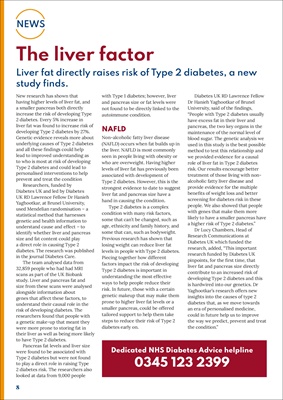
8
NEWS
Dedicated NHS Diabetes Advice helpline
0345 123 2399
The liver factor
Liver fat directly raises risk of Type 2 diabetes, a new
study finds.
New research has shown that
having higher levels of liver fat, and
a smaller pancreas both directly
increase the risk of developing Type
2 diabetes. Every 5% increase in
liver fat was found to increase risk of
developing Type 2 diabetes by 27%.
Genetic evidence reveals more about
underlying causes of Type 2 diabetes
and all these findings could help
lead to improved understanding as
to who is most at risk of developing
Type 2 diabetes and could lead to
personalised interventions to help
prevent and treat the condition
Researchers, funded by
Diabetes UK and led by Diabetes
UK RD Lawrence Fellow Dr Hanieh
Yaghootkar, at Brunel University,
used Mendelian randomisation - a
statistical method that harnesses
genetic and health information to
understand cause and effect - to
identify whether liver and pancreas
size and fat content could play
a direct role in causing Type 2
diabetes. The research was published
in the journal Diabetes Care.
The team analysed data from
32,859 people who had had MRI
scans as part of the UK Biobank
study. Liver and pancreas fat and
size from these scans were analysed
alongside information about
genes that affect these factors, to
understand their causal role in the
risk of developing diabetes. The
researchers found that people with
a genetic make-up that meant they
were more prone to storing fat in
their liver as well as being more likely
to have Type 2 diabetes.
Pancreas fat levels and liver size
were found to be associated with
Type 2 diabetes but were not found
to play a direct role in raising Type
2 diabetes risk. The researchers also
looked at data from 9,000 people
with Type 1 diabetes; however, liver
and pancreas size or fat levels were
not found to be directly linked to the
autoimmune condition.
NAFLD
Non-alcoholic fatty liver disease
(NAFLD) occurs when fat builds up in
the liver. NAFLD is most commonly
seen in people living with obesity or
who are overweight. Having higher
levels of liver fat has previously been
associated with development of
Type 2 diabetes. However, this is the
strongest evidence to date to suggest
liver fat and pancreas size have a
hand in causing the condition.
Type 2 diabetes is a complex
condition with many risk factors,
some that can't be changed, such as
age, ethnicity and family history, and
some that can, such as bodyweight.
Previous research has shown that
losing weight can reduce liver fat
levels in people with Type 2 diabetes.
Piecing together how different
factors impact the risk of developing
Type 2 diabetes is important in
understanding the most effective
ways to help people reduce their
risk. In future, those with a certain
genetic makeup that may make them
prone to higher liver fat levels or a
smaller pancreas, could be offered
tailored support to help them take
steps to reduce their risk of Type 2
diabetes early on.
Diabetes UK RD Lawrence Fellow
Dr Hanieh Yaghootkar of Brunel
University, said of the findings,
"People with Type 2 diabetes usually
have excess fat in their liver and
pancreas, the two key organs in the
maintenance of the normal level of
blood sugar. The genetic analysis we
used in this study is the best possible
method to test this relationship and
we provided evidence for a causal
role of liver fat in Type 2 diabetes
risk. Our results encourage better
treatment of those living with nonalcoholic
fatty liver disease and
provide evidence for the multiple
benefits of weight loss and better
screening for diabetes risk in these
people. We also showed that people
with genes that make them more
likely to have a smaller pancreas have
a higher risk of Type 2 diabetes."
Dr Lucy Chambers, Head of
Research Communications at
Diabetes UK which funded the
research, added, "This important
research funded by Diabetes UK
pinpoints, for the first time, that
liver fat and pancreas size directly
contribute to an increased risk of
developing Type 2 diabetes and this
is hardwired into our genetics. Dr
Yaghootkar's research offers new
insights into the causes of type 2
diabetes that, as we move towards
an era of personalised medicine,
could in future help us to improve
the way we predict, prevent and treat
the condition."